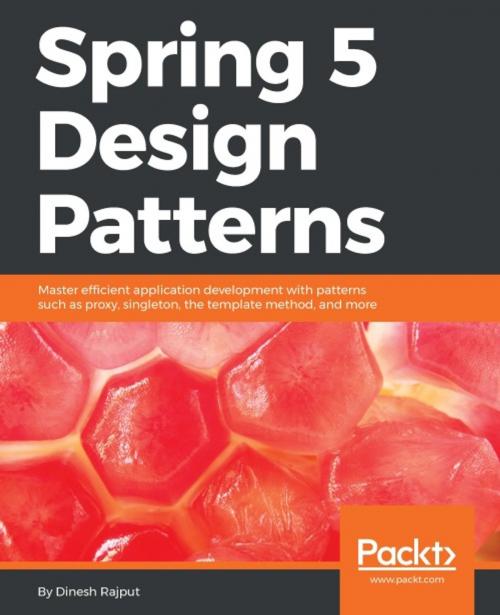Spring 5 Design Patterns
Nonfiction, Computers, Internet, Web Development, Java, Programming, Programming Languages| Author: | Dinesh Rajput | ISBN: | 9781788299596 |
| Publisher: | Packt Publishing | Publication: | October 6, 2017 |
| Imprint: | Packt Publishing | Language: | English |
| Author: | Dinesh Rajput |
| ISBN: | 9781788299596 |
| Publisher: | Packt Publishing |
| Publication: | October 6, 2017 |
| Imprint: | Packt Publishing |
| Language: | English |
Learn various design patterns and best practices in Spring 5 and use them to solve common design problems.
About This Book
- Explore best practices for designing an application
- Manage your code easily with Spring's Dependency Injection pattern
- Understand the benefits that the right design patterns can offer your toolkit
Who This Book Is For
This book is for developers who would like to use design patterns to address common problems while designing an app using the Spring Framework and Reactive Programming approach. A basic knowledge of the Spring Framework and Java is assumed.
What You Will Learn
- Develop applications using dependency injection patterns
- Learn best practices to design enterprise applications
- Explore Aspect-Oriented Programming relating to transactions, security, and caching.
- Build web applications using traditional Spring MVC patterns
- Learn to configure Spring using XML, annotations, and Java.
- Implement caching to improve application performance.
- Understand concurrency and handle multiple connections inside a web server.
- Utilizing Reactive Programming Pattern to build Reactive web applications.
In Detail
Design patterns help speed up the development process by offering well tested and proven solutions to common problems. These patterns coupled with the Spring framework offer tremendous improvements in the development process.
The book begins with an overview of Spring Framework 5.0 and design patterns. You will understand the Dependency Injection pattern, which is the main principle behind the decoupling process that Spring performs, thus making it easier to manage your code. You will learn how GoF patterns can be used in Application Design. You will then learn to use Proxy patterns in Aspect Oriented Programming and remoting. Moving on, you will understand the JDBC template patterns and their use in abstracting database access. Then, you will be introduced to MVC patterns to build Reactive web applications. Finally, you will move on to more advanced topics such as Reactive streams and Concurrency.
At the end of this book, you will be well equipped to develop efficient enterprise applications using Spring 5 with common design patterns
Style and approach
The book takes a pragmatic approach, showing various design patterns and best-practice considerations, including the Reactive programming approach with the Spring 5 Framework and ways to solve common development and design problems for enterprise applications.
Learn various design patterns and best practices in Spring 5 and use them to solve common design problems.
About This Book
- Explore best practices for designing an application
- Manage your code easily with Spring's Dependency Injection pattern
- Understand the benefits that the right design patterns can offer your toolkit
Who This Book Is For
This book is for developers who would like to use design patterns to address common problems while designing an app using the Spring Framework and Reactive Programming approach. A basic knowledge of the Spring Framework and Java is assumed.
What You Will Learn
- Develop applications using dependency injection patterns
- Learn best practices to design enterprise applications
- Explore Aspect-Oriented Programming relating to transactions, security, and caching.
- Build web applications using traditional Spring MVC patterns
- Learn to configure Spring using XML, annotations, and Java.
- Implement caching to improve application performance.
- Understand concurrency and handle multiple connections inside a web server.
- Utilizing Reactive Programming Pattern to build Reactive web applications.
In Detail
Design patterns help speed up the development process by offering well tested and proven solutions to common problems. These patterns coupled with the Spring framework offer tremendous improvements in the development process.
The book begins with an overview of Spring Framework 5.0 and design patterns. You will understand the Dependency Injection pattern, which is the main principle behind the decoupling process that Spring performs, thus making it easier to manage your code. You will learn how GoF patterns can be used in Application Design. You will then learn to use Proxy patterns in Aspect Oriented Programming and remoting. Moving on, you will understand the JDBC template patterns and their use in abstracting database access. Then, you will be introduced to MVC patterns to build Reactive web applications. Finally, you will move on to more advanced topics such as Reactive streams and Concurrency.
At the end of this book, you will be well equipped to develop efficient enterprise applications using Spring 5 with common design patterns
Style and approach
The book takes a pragmatic approach, showing various design patterns and best-practice considerations, including the Reactive programming approach with the Spring 5 Framework and ways to solve common development and design problems for enterprise applications.















